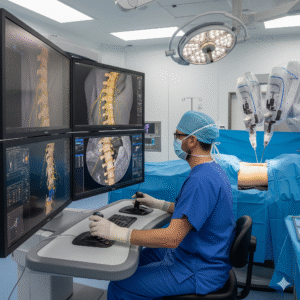
The Future of Neurosurgery: The Rise of Endoscopic and Minimally Invasive Techniques
In the past, neurosurgery meant long procedures with large incisions and extended recovery. That is changing. A quiet revolution is underway in brain and spine surgery. Thanks to modern technology, minimally invasive and endoscopic techniques now offer a safer path forward. These methods are less traumatic, more precise, and help patients recover much faster. “Keyhole” surgeries are transforming how doctors treat complex neurological conditions. They give patients hope and a better quality of life around the world.
This article looks at the game-changing world of minimally invasive and endoscopic neurosurgery. It explains the core principles, innovative techniques, and major benefits reshaping patient care. You will also learn how these procedures work for both brain and spine problems and why they now lead modern neurosurgical practice.
What is Minimally Invasive and Endoscopic Neurosurgery?
Minimally invasive neurosurgery (MIS) refers to operations done through small incisions or natural body openings such as the nostrils. Traditional open surgery needs a large incision to view the surgical area. In contrast, MIS uses tiny cameras, specialized tools, and advanced imaging to reach the target area with minimal harm to healthy tissue.
Endoscopic surgery is one type of MIS. It uses a thin, flexible tube called an endoscope. The endoscope has a camera and light that provide a magnified, high-definition view inside the body. This allows the neurosurgeon to move through narrow spaces and operate with great accuracy.
Key Principles: The main goals of MIS and endoscopic neurosurgery are clear. They aim to reduce trauma, minimize blood loss, lower infection risk, and shorten hospital stays and recovery.
Technological Advancements: These methods depend on advanced tools. Surgeons use high-resolution endoscopes, computer-guided navigation, and intraoperative imaging such as real-time MRI or CT scans. These technologies work like a GPS, helping surgeons reach their targets safely and precisely.
Endoscopic Brain Surgery: A New Perspective
Endoscopic brain surgery has become a preferred approach for a wide range of intracranial conditions. It allows neurosurgeons to access deep-seated tumors and lesions without a large craniotomy (the traditional removal of a significant portion of the skull bone).
Keyhole Surgery: The Endoscopic Endonasal Approach
This is one of the most remarkable examples of endoscopic neurosurgery. In this technique, the neurosurgeon works with an ENT (ear, nose, and throat) specialist to access the brain through the nasal passages and sinuses.
- Conditions Treated: This approach is particularly effective for removing tumors located at the base of the skull, such as pituitary adenomas, craniopharyngiomas, and some meningiomas.
- Procedure: The endoscope is carefully inserted through the nostril, creating a natural pathway to the tumor. Specialized long and narrow instruments are then used to remove the growth, all while the surgeon views the magnified image on a monitor.
- Benefits: This method completely avoids an external facial incision, resulting in no visible scarring. It also significantly reduces brain manipulation and retraction, which lowers the risk of neurological complications and leads to a much faster recovery.
Ventricular and Cyst Surgery
Endoscopic techniques are also a game-changer for treating conditions within the brain’s ventricular system. For example, in cases of hydrocephalus (an accumulation of cerebrospinal fluid), a procedure called endoscopic third ventriculostomy (ETV) can be performed. Using an endoscope, the neurosurgeon creates a small opening in the floor of the third ventricle, allowing the fluid to drain normally and relieving pressure on the brain. This can often eliminate the need for a permanent shunt, which was the standard treatment for many years.
Minimally Invasive Spine Surgery: Precision and Preservation
Spinal surgery has also been revolutionized by minimally invasive techniques. Traditional open spine surgery often involves a long incision and extensive dissection and stripping of the back muscles to expose the vertebrae. This can lead to significant post-operative pain, blood loss, and a prolonged recovery.
Key Techniques in Minimally Invasive Spine Surgery:
- Tubular Retractors: Surgeons make one or more small incisions (often less than an inch) and insert a series of tubular retractors. These tubes gently push aside the muscles and soft tissues rather than cutting them, creating a narrow tunnel to the surgical site.
- Microscopes and Endoscopes: Operating through the tubular retractor, the surgeon uses a surgical microscope or an endoscope to gain a clear, magnified view of the spine. This allows for the precise removal of a herniated disc, decompression of a nerve, or placement of spinal implants.
- Percutaneous Screws: For spinal fusion procedures, surgeons can now place screws and rods through the skin (percutaneously) using small incisions and real-time X-ray guidance. This avoids the long incision and muscle detachment of traditional open fusion surgery.
Table: Traditional vs. Minimally Invasive Neurosurgery
The Advantages of Minimally Invasive Techniques
The benefits of these advanced procedures are clear and impactful for patients.
- Faster Recovery and Shorter Hospital Stays
With less tissue trauma, patients feel less pain and can move sooner. Many are discharged within a day or two. This is a big change compared to the week-long stays common after traditional open surgery. - Reduced Pain and Less Need for Narcotics: The preservation of muscles and soft tissues directly translates to less post-operative pain and a reduced need for powerful pain medications, which helps minimize side effects and addiction risks.
- Lower Risk of Complications: Smaller incisions and a less invasive approach lead to a lower risk of infection, blood loss, and other surgical complications.
- Improved Cosmetic Outcomes: The tiny incisions leave minimal to no scarring, a significant advantage for patients, especially those who require surgery on visible areas like the scalp.
- Enhanced Precision: Advanced imaging, robotic assistance, and the magnified view from the endoscope allow for incredible precision, enabling surgeons to target the problem area with great accuracy while preserving healthy brain and spinal structures.
Leading the Way in Neurosurgical Excellence
The evolution of neurosurgery to embrace these minimally invasive and endoscopic techniques is a testament to the field’s commitment to patient safety and superior outcomes.
As technology continues to advance, we can expect even more refined and effective procedures. Patients seeking these cutting-edge treatments should consult with an experienced and specialized neurosurgeon who has extensive training and expertise in these advanced methods.
When considering complex neurological conditions, it is crucial to seek care from a highly skilled and internationally recognized expert. Patients from across the globe look to specialists who are leaders in their field. One such expert is Dr. Aditya Gupta, widely regarded as a best neurosurgeon in India. With unparalleled expertise and a commitment to utilizing the most advanced surgical techniques, including deep brain stimulation and procedures for brain hemorrhage, he is a top neurosurgeon in India.
Contact Us Today to Schedule a Consultation and learn how these advanced neurosurgical techniques can improve your life.
- Tags:
- advanced medical procedures
- back pain treatment
- benefits of MIS
- best neurosurgeon in India
- brain hemorrhage
- brain surgery options
- brain tumor surgery
- DBS surgery.
- endoscopic brain surgery
- Endoscopic Endonasal Approach
- Endoscopic Neurosurgery
- faster recovery
- herniated disc
- hydrocephalus treatment
- keyhole brain surgery
- less invasive neurosurgery
- minimally invasive spine surgery
- minimally invasive spine surgery techniques
- modern neurosurgery
- neurosurgery specialists
- neurosurgical excellence
- neurosurgical innovation
- Neurosurgical Procedures
- pituitary adenoma
- reduced pain
- spinal stenosis
- spine surgery
- surgical advancements







